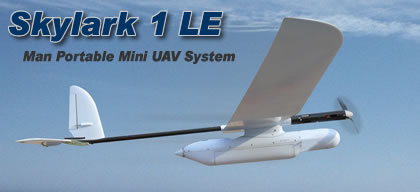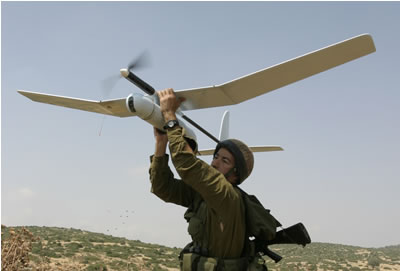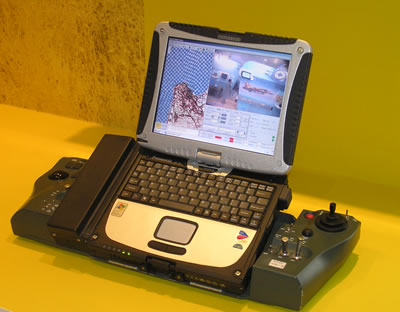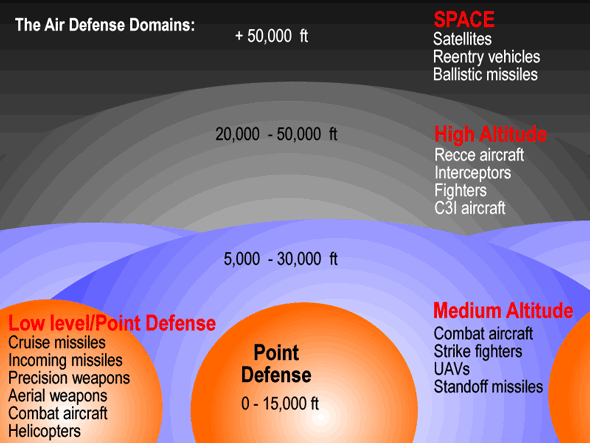A new seekerless precision strike weapon system developed by Lockheed Martin, could revolutionize next-generation strike weapons. This all-weather, precision standoff seekerless 1,000 lb weapon uses an inexpensive wing set to provide maneuvering G’s and energy to interdict evasive targets. Target cuing is received via datalink from other sensors, resulting in a near-zero navigation Circular Error Probability (CEP). The weapon uses low-cost, two-way data link to receive continuous corrections to the current GPS system, providing a direct hit without the use of an end-game seeker. The datalink provides weapon tracking and status. PNAV is expected to be a key ingredient in future Small Diameter Bomb (SDB) applications, as it enables reduction of CEP well below the 4meter requirement without a costly seeker.
GlobaLight Satellite Communications terminal
Elbit Systems / Nice Systems
Elbit System’s GlobaLight SATCOM Very Small Aperture Terminal (VSAT) can supports command post with two data (LAN) lines and two voice (phone) lines with total capacity of up to 2Mbps downlink and 500 kbps for the uplink – adequate for most multimedia, video rich applications.
Ghost Signature Reduction System
Natural body heat creates a distinctive signature inherent to human body, therefore, Infantrymen appear conspicuously hot on thermal image. Personal camouflage should significantly reduce heat signature reduction in addition to visual camouflage provided by the color scheme. The German company TEXPLORER has developed Ghost – a metallized fabric creating such an effect. The washable, reusable fabric can be adapted to all types of countryside and temperature ranges with various background printed patterns.
Active Radar / Milimeter Wave
Precision Targeting System
Radar (active) guidance technology prevailed in anti-ship and surface attack weapons during the 1980s. This guidance technique was recently adapted to land attack missiles. After the missile flies to a pre-designated location where line of sight to the target is expected, it activates its radar in a scan mode, and will home in on the signal expected to be the target. Such signal can be the strongest in the area, or one that emits a characteristic signature. Radar guided missiles are highly vulnerable to countermeasures and deception, which sometime necessitate human intervention for target verification and intervention at terminal phase. When used over land, radar seekers can be augmented by other elements (such as EO, GPS, LADAR etc).
Other applications of much smaller radar guidance use millimeter wave radars, to locate, classify, identify and engage armored vehicles and other priority targets. The use of millimeter wave seekers provides very high resolution, all weather capability and high immunity to current conventional countermeasure techniques employed by armored vehicles.
Modernized GPS IIR-M Satellite
The Lockheed Martin GPS IIR-M spacecraft offer a variety of enhanced features for GPS users, such as a modernized antenna panel that provides increased signal power to receivers on the ground, two new military signals for improved accuracy, enhanced encryption and anti-jamming capabilities for the military, and a second civil signal that will provide users with an open access signal on a different frequency. The Global Positioning System enables properly equipped users to determine precise time and velocity and worldwide latitude, longitude and altitude to within a few meters.
The second satellite was launched on Sept 25, 2006. It will join the first modernized IIR satellite, GPS IIR-14(M), successfully launched and declared operational last year and 12 other operational Block IIR satellites currently on-orbit within the overall 29-spacecraft constellation.
BONUS Artillery Launched Precision Guided Munitions
 Bonus artillery launched, fire-and-forget artillery shell targets and destroys armored vehicles (stationary or mobile) by top attack submunitions. Each BONUS shell carries two BONUS Submunitions, and is provided with base bleed system to reach ranges of 35km. Two Submunitions are carried in each shell, covering an area of 200 m’ in radius. The BONUS submunition deploys two “wings” which stabilize its rapid descent path and fast spin required for target scanning. BONUS acquires a target by multi-spectral infrared signature. BONUS II, which will enter production in 2005 will also add a laser radar (LADAR) for improved aiming into a target shape generated by a laser radar (LADAR) sensor. The fusion of spectral and target profile enables BONUS to separate between combat-worthy targets, damaged or burning targets as well as decoys. Each submunition is equipped with explosive formed penetrator (EFP) striking the target by top attack. BONUS II is equipped with improved IR sensors capable of engaging targets with reduced IR signatures and countermeasures. BONUS is in production since 2003. Over 1000 BONUS shells have already been delivered to the French and Swedish armies, and current production programs are scheduled to last til 2007
Bonus artillery launched, fire-and-forget artillery shell targets and destroys armored vehicles (stationary or mobile) by top attack submunitions. Each BONUS shell carries two BONUS Submunitions, and is provided with base bleed system to reach ranges of 35km. Two Submunitions are carried in each shell, covering an area of 200 m’ in radius. The BONUS submunition deploys two “wings” which stabilize its rapid descent path and fast spin required for target scanning. BONUS acquires a target by multi-spectral infrared signature. BONUS II, which will enter production in 2005 will also add a laser radar (LADAR) for improved aiming into a target shape generated by a laser radar (LADAR) sensor. The fusion of spectral and target profile enables BONUS to separate between combat-worthy targets, damaged or burning targets as well as decoys. Each submunition is equipped with explosive formed penetrator (EFP) striking the target by top attack. BONUS II is equipped with improved IR sensors capable of engaging targets with reduced IR signatures and countermeasures. BONUS is in production since 2003. Over 1000 BONUS shells have already been delivered to the French and Swedish armies, and current production programs are scheduled to last til 2007
Diamond Back Weapon’s Guidance Kit
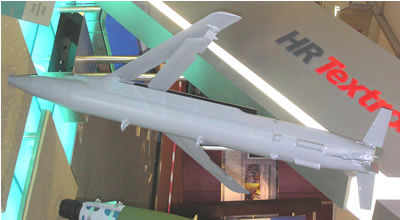 MBDA is developing a range extension kit for the SDB designated Diamond-Back. The kit features a tandem-wing design which integrates with the weapon guidance. When stored and carried by the aircraft, the wings are stored in a compact assembly on the back of the weapon.
MBDA is developing a range extension kit for the SDB designated Diamond-Back. The kit features a tandem-wing design which integrates with the weapon guidance. When stored and carried by the aircraft, the wings are stored in a compact assembly on the back of the weapon.
When released, the wings are extracted to form a diamond shaped structure deployed extending the weapon’s footprint over 20 times, compared to a basic weapon. This capability allows a single platform to engage multiple targets dispersed over a large area. MBDA plans to extend the Diamond Back kits to support 500 lb, 1000 lb and 2000 lbs JDAM munitions.
Corrected Trajectory Artillery Projectile (CTAP)
IMI has developed a GPS based guided 155mm artillery projectile which corrects its trajectory in two dimensions (range and azimuth). The system is implemented as retrofit for existing ammunition, with introduction of GPS/IMU guidance, navigation and control subsystems, controlling canard winglets for aerodynamic control. The canards and the “Pure Heart” guidance system are deployed after the apogee point, to gain maximum range.
Skylark 1 LE Mini Unmanned Aerial vehicle (Mini-UAV)
Elbit has developed the Skylark miniature UAVs, a manpacked system designed for tactical close-range surveillance and reconnaissance missions, artillery fire adjustments as well as force protection and perimeter security.
The mini UAV is quickly assembled before the mission and is launched by hand. Recovery is performed by a deep stall maneuver, which lands the vehicle safely on a small inflatable cushion, at a pre-designated point. The cushion is designed to protect the payload on landing. The entire mission is flown autonomously, feeding real-time continuous video and telemetry data to the portable ruggedized ground station. Its wings and tail surfaces are constructed of a lightweight composites, the fuselage tubular boom is also made of composites.
The avionics and payload systems are contained in a pod carried below the boom. The gimbaled payload utilizes a daylight CCD or an optional FLIR for night operation, which can be rotated by four gimbals. In February 2004 Elbit won an IDF Ground Forces Command contract to supply the Skylark for evaluation and testing as an organic UAV system, to be operated by infantry units.Skylark has since entered operational service with selected IDF units, used for operational testing and doctrine development and evaluation.During the Second Lebanon war in July-August 2006, Skylark mini-UAVs were operated by IDF units performing close-in reconnaissance missions in support of the ground forces, providing valuable real-time intelligence, due to their low acoustic and visual signatures, Skylarks were able to operate at very low altitude practically undetectable.
 In 2005 the Australian MOD selected the Skylark to support the deployment of Australian forces in Iraq. Six systems were procured and deployed to Southern Iraq. In September, 2006 Thales Canada announced it has been selected by the Department of National Defence Land Forces to deliver a mini-UAV system based on Elbit’s Skylark technology. France has also procured the system for its Special Forces. Sweden and the Netherlands are also evaluating the systems, operating small quantities bought for operational evaluation. By December 2008, the Israel Defense Forces has selected an enhanced version of Elbit System’s Skylark mini- UAV for operation at the battalion level.
In 2005 the Australian MOD selected the Skylark to support the deployment of Australian forces in Iraq. Six systems were procured and deployed to Southern Iraq. In September, 2006 Thales Canada announced it has been selected by the Department of National Defence Land Forces to deliver a mini-UAV system based on Elbit’s Skylark technology. France has also procured the system for its Special Forces. Sweden and the Netherlands are also evaluating the systems, operating small quantities bought for operational evaluation. By December 2008, the Israel Defense Forces has selected an enhanced version of Elbit System’s Skylark mini- UAV for operation at the battalion level.
The original Skylark I used a miniature gyro stabilized payload weighing only 500gr. The payload was developed by Elbit Systems specifically for MAV applications. It consists of a daylight color CCD. When fitted with night-camera, the payload’s weight doubles to one kilogram. Payload-vehicle integration enables simple and intuitive operation in holding position, as the payload “looks” at a designated point while the UAV circles above to maintain a continuous cover, and camera guide, where the user designates a target or rout to be followed by the payload and aircraft. Image obtained by the camera are overlaid on the integrated map situational display. The Skylark 1 LE uses a different payload called STAMP stabilized miniature payload developed by Controp, available in daylight, night, uncooled thermal and HD configurations.
The new Skylark 1LE configuration offers many enhancements over the original Skylark, primarily 50% increased endurance (3 hours), operational altitude (- 700 ft. to +3000 ft above or below the takeoff point), operational ceiling of 15,000 ft and extended mission radius of up to 15 km, (50 – 100% increase over the original model). The wing span has been increased by 70 cm to 2.9 meters and maximum gross takeoff weight increased by 600 gram from 6.1 (6.3 in the night mission configuration).
While the small UAV is simple to operate, as it is guided autonomously throughout the mission (even in GPS denied terrain) Elbit Systems is offering an optional integrated video simulator to improve training, enabling operators to better understand and plan a mission, based on realistic views of the expected target. Other optional enhancements include an auxiliary operating console, to be operated at the battalion command team.
Net Centric Air Defense Systems
Many armies are currently modernizing their air defense assets. Current systems are obsolete today, as they rely on armament systems developed and fielded in the 1960 – 1980s. Modernizations and acquisition of new systems target various aspects of these air defense weapons by improving their capabilities against sophisticated threats. This includes enhanced target detection, tracking and engagement under intensive ECM and adverse weather conditions, and the use of passive sensors or introduction of multi-sensors (active/passive). Multi-weapon (missiles and guns) combinations, on a single platform are favored. The latest trend is adding networking capability, combining multiple sensors, firing units as well as interjacent, but different weapon systems. Networking enables fire units to share and coordinate operations on a wider scale, while retaining high level of independence, ensuring continuation of operation, while under attack.
A typical deployed air defense system utilizes sensors, communications and mobile or relocateable missile launchers. All the system’s elements can be remotely operated from regional battle management & control centers and interface with the network via data-links and wireless communications. The sensors include wide area coverage by radar, reinforced by active and passive sensors – such as infrared search & trackers (IRST) and passive radars (detecting and localizing electronic emissions from aircraft and cruise missiles).
Missiles dedicated for such network centric systems often use Lock-On After launch targeting techniques, which enable the weapons to be launched “blind”, or broadly toward a “kill-box” where the target is expected to be. The final target data and intercept parameters are sent to the missile via datalink during the flight, and are further updated before the terminal intercept, to respond to potential evasive maneuvers and countermeasures dispensed by the target. Another advantage of networked air defense elements is its capability to engage a single target by several missiles, from different directions, therefore gaining high probability of kill. This capability is especially important when defending against saturation attacks. When tasked against multiple attacks, missiles can be retargeted in mid-course toward other airborne threats, when the primary target has been destroyed by one of the missiles, utilizing its extended range for mid-course update capability.
Another common feature for network based air defenses is the use of the Vertical Launch (VL) system. This capability utilizes a thrust vector flight control system, that position the missile quickly after launch, at a medium altitude and in the general direction of the target. From this position the missile has superior acquisition of the target in short range engagements. Typical VL systems can launch multiple missiles to engage targets at different sectors, in quick succession. VL capability also eliminates the need for complex, heavy mechanical traverse and elevation systems, required for missile positioning. VL is utilized with many modern missiles including the SAMP/T (Aster 30), Mica VL, Umkhonto, Defender (Barak I), Barak NG and IRIS-T SL. Non VL systems offer other advantages, including rapid response rates in short range engagements, where pop-up targets, missiles and guided weapons are intercepted. Typical non VL systems are the Raytheon / Kongsberg SLAMRAAM, RAFAEL/IAI SPYDER, and Pantsir S1. In order to provide full coverage, such systems are commonly assigned specific defensive sectors of 120 degrees or less.
Further into the future, more revolutionary, directed energy weapons such as the Mobile Tactical High Energy Laser (MTHEL) will probably become the first mobile directed energy weapon to be able to destroy tactical airborne threats in midair. MTHEL type weapons are expected to provide an air defense shield for expeditionary forces and civilians areas which are exposed to a threat of rocket, mortars or artillery attacks.
Additional parts of this article:
- Mobile Short Range Air Defense Systems
- Modern Air Defense Concepts
- SHORAD Transformation
- Net Centric Air Defense Systems
SHORAD Transformation
Further enhancement of the integrated air defense systems approach is the layered air defense concept, which encompasses various systems into an integrated “near zero leak” air defense. The layered air defense system protects a site by defeating multiple attacks of various types of armaments. Layered air defense systems usually consist of three tiers – the extended range combat layer, where short to medium range missiles engage targets such as attack aircraft and unmanned platforms flying at medium to high altitude, and attack aircraft or cruise missiles flying at a low to very low level. The systems operated at this layer must retain “look-down/shoot-down” operating capability, by screening targets against ground clutter. This capability should be provided both to the sensors, guidance systems and weapon systems. This protection level should also be able to engage enemy combat support elements, such as electronic surveillance and target designators.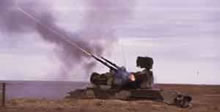
The second “close-in” combat layer, which employs radar controlled guns and Very SHO Range Air Defense missiles (VSHORAD) missiles, such as SA-7/14/18, Stinger and Mistral, should also provide anti-missile protection. These weapons should target the precision strike weapons which, having penetrated the first layer, are threatening the defended site. Typical targets engaged at this level are guided weapons, UAVs, unmanned attack vehicles and gunship helicopters. A mix of systems is appropriate at this level. Most missiles are effective against aircraft and helicopters, while advanced automatic, air defense guns could be efficient against guided weapons, when equipped with advanced systems such as the Russian Tungushka or Swiss AHEAD technology.
The integrated gun-missile systems (such as Tunguska and Pantsir) offer an impressive capability, especially for point and tactical mobile air defense. However, even with their formidable firepower, such systems cannot act independently. Some analysts are questioning the claimed effectiveness of the 30mm gun at maximum range (3,000 – 4,000 meters), where its capability against small targets (missiles guided weapons and helicopters) is questionable, as kill probability drops well below 50%. With such low yield, the air defense vehicle has an inherent “dead zone” at ranges between 1,500 – 2,500 m’, where the hit probability of the gun drops sharply and the missile cannot engage the target. Therefore, mutual coverage of firing units should be employed to eliminate this deficiency.
The progress of modern air defense systems is being augmented by the modernization of active, passive and networked air defense sensors.
Additional parts of this article:
- Mobile Short Range Air Defense Systems
- Modern Air Defense Concepts
- SHORAD Transformation
- Net Centric Air Defense Systems
Mobile Short Range Air Defense Systems
Start < Page 1 of 4 >
The devastating effect of modern airpower was demonstrated repeatedly in recent conflicts – in the continued confrontation in Iraq, from 1991 through 2003, the successful application of allied airpower brought some analysts to argue that airpower alone could win a war. However, military planners are less enthusiastic about the airpower’s “silver bullet” and see its best application as part of a joint operation, extensively networked with combat formations on land, at sea and in space. For armies other than the US, the air warfare demonstrated in the two recent conflicts with Iraq was somewhat of a peek into the distant future – and not a realistic scenario they can “copy and paste” into their operational planning. The coalition forces had several unique advantages – political and technological – on their side. These included the decade long ability to pound the Iraqi air defenses, by offensive patrols operated over the “no flying zones”, the use of stealth weaponry, including strike aircraft and cruise missiles, during the initial phase of the conflict and virtually unlimited access to intelligence information, provided by platforms operating beyond the reach of conventional defenses – including spy satellites of various types and high flying UAVs like Global Hawk UAVs. A more restricted use of the same assets, during the Kosovo conflict, was executed under strict operational and political limitations and yielded less dramatic results.
In 100 years of operation, harnessing leading edge technologies and advanced science, airpower has matured and became efficient, precise and devastating. Most evidently since the end of the cold war, the characteristic profile of the aerial threat changed dramatically, from direct, over the target attack by large masses of bombers, or nuclear attacks with long range ballistic and cruise missiles, to attacks by a small number of precision guided weapons, launched from aircraft beyond the effective range of the target’s defenses. Cruise missiles have also evolved, to become stealthier, fly lower, faster and attack with higher precision. Unmanned aerial vehicles are maturing as well, and are expected to replace some of the manned attack missions in the near future. The main differentiators between modern and past capabilities are the growing separation between the attacker and his intended target, by the use of autonomous or guided, standoff weapons. Supporting technologies are ensuring high probability of target hit, by evading detection of the strike aircraft and the attack weapons, by the application of stealth techniques, use of electronic warfare for confusion, deception and seduction of enemy defenses, and the suppression and destruction of radars and air defenses, prior to the attacks of key strategic targets.
In some combat scenarios, dedicated weapons are tailored to challenge the target’s characteristics, defenses and countermeasures. For example, point targets such as air surveillance radar sites, command centers and communications nodes, are being targeted by a wide range of high speed, anti-radiation missiles, some of which can “memorize” the emitter’s locations even after the radar shuts down trying to evade such attack. Precision guided munitions are employed in attacks of fixed sites. Stationary targets, whose locations are known, are targeted by autonomous weapons that can sense the targets at the predicted location – modern cruise missiles will fly autonomously and seek the target by their integral sensors as well as scene matching techniques. Typical attacks are performed from long range and high to medium altitude, to achieve maximum standoff range. It is expected that by the year 2010 half of the attacks of such targets will be performed by autonomous weapons such as cruise missiles and Unmanned Combat Aerial Vehicles (UCAV). The remaining half will consist of manned missions, utilizing standoff precision guided weapons, to minimize the risk for the attacking aircraft. The modern technology enables attacks of “surgical” precision, with smaller weapons, resulting in lower consumption of munitions, increasing the total number of attackable targets. Due to the use of such smaller warheads, these “surgical” weapons cause less collateral damage and therefore, more targets can be engaged in or near civilian environment, including power, energy and communications centers, as well as the classic military targets.
Effective air defense systems are imperative to contain such threats. Therefore, each of the recent campaigns began with the crippling and destruction of enemy air defenses, starting from blinding and destroying the “eyes and ears” – radars and command centers, following with a systematic hunting and destruction of Surface to Air Missiles (SAM) and Anti-Aircraft Artillery (A3).
Additional parts of this article:
- Mobile Short Range Air Defense Systems
- Modern Air Defense Concepts
- SHORAD Transformation
- Net Centric Air Defense Systems





